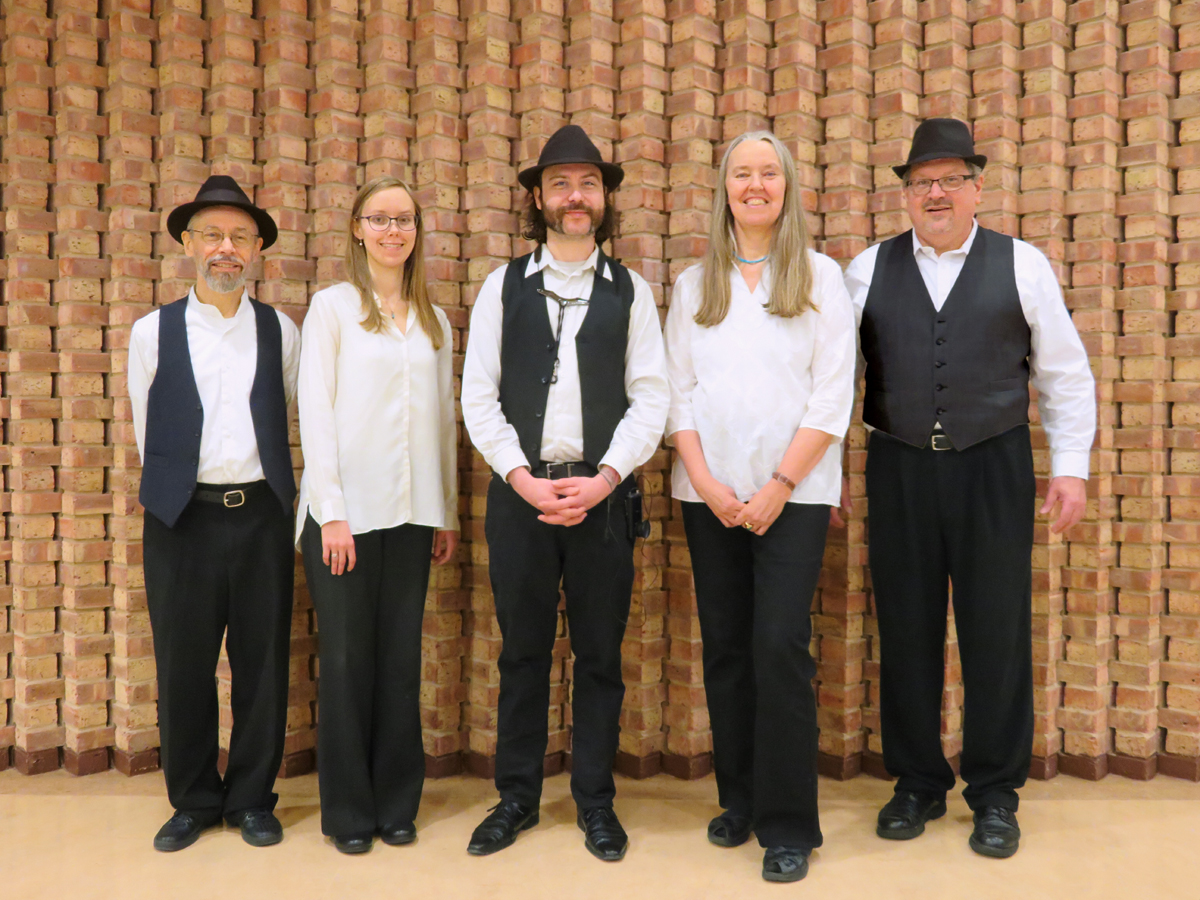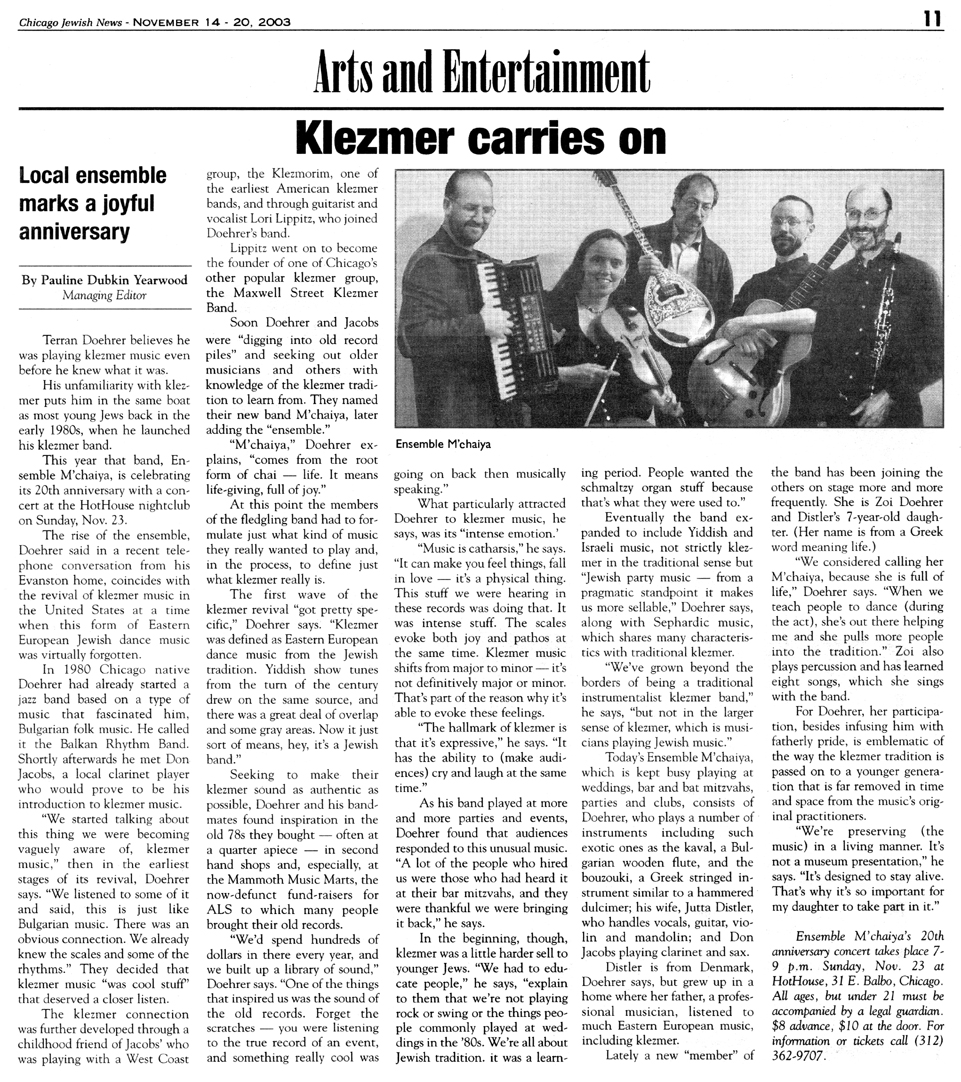ENSEMBLE
M’CHAIYA

Klezmer carries on
Local ensemble marks a joyful anniversary
Evanston Round Table — Arts and Entertainment section, by Pauline Dubkin Yearwood, Managing Editor, November 14, 2003.

Terran Doehrer believes he was playing klezmer music even before he knew what it was.
His unfamiliarity with klezmer puts him in the same boat as most young Jews back in the early 1980s when he launched his klezmer band.
This year that band, the Ensemble M’chaiya (tm), is celebrating its 20th anniversary with a concert at the HotHouse nightclub on Sunday, Nov. 23.
The rise of the ensemble, Doehrer said in a recent telephone conversation from his Evanston home, coincides with the revival of klezmer music in the United States at a time when this form of Eastern European Jewish dance music was virtually forgotten.
In 1980 Chicago native Doehrer had already started a jazz band based on a type of music that fascinated him, Bulgarian folk music. He called it the Balkan Rhythm Band (tm). Shortly afterwards he met Don Jacobs, a local clarinet player who would prove to be his introduction to klezmer music.
“We started talking about this thing we were becoming vaguely aware of, klezmer music,” then in the earliest stages of its revival, Doehrer says. “We listened to some of it and said, this is just like Bulgarian music. There was an obvious connection. We already knew the scales and some of the rhythms.” They decided that klezmer music “was cool stuff” that deserved a closer listen.
The klezmer connection was further developed through a childhood friend of Jacobs’ who was playing with a West Coast group, the Klezmorim, one of the earliest American klezmer bands, and through guitarist and vocalist Lori Lippitz, who joined Doehrer’s band. [Editor’s correction: Doehrer and Jacobs had already heard the Klezmorim and were actively practicing the musical style when Mz Lippitz joined the Ensemble M’chaiya.]
Lippitz went on to become the founder of one of Chicago’s other popular klezmer group, the Maxwell Street Klezmer Band.
Soon Doehrer and Jacobs were “digging into old record piles” and seeking out older musicians and others with knowledge of the klezmer tradition to learn from. They named their new band M’chaiya, later adding the “ensemble.”
“M’chaiya,” Doehrer explains, “comes from the root form of chai — life. It means live-giving, full of joy.”
At this point the members of the fledgling band had to formulate just kind of music they really wanted to play and, in the process, to define just what klezmer really is.
The first wave of the klezmer revival “got pretty specific,” Doehrer says. “Klezmer was defined as Eastern European dance music from the Jewish tradition. Yiddish show tunes from the turn of the century drew on the same source, and there was a great deal of overlap and some gray areas. Now it just sort of means, hey, it’s a Jewish band.”
Seeking to make their klezmer sound as authentic as possible, Doehrer and his bandmates found inspiration in the old 78s they bought — often at a quarter apiece — in second hand shops and, especially, at the Mammoth Music Marts, the now-defunct fund-raisers for ALS to which many people brought their old records.
“We’d spend hundreds of dollars in there every year, and we built up a library of sound,” Doehrer says. “One of the things that inspired us was the sound of the old records. Forget the scratches — you were listening to the true record of an event, and something really cool was going on back then musically speaking.”
What particularly attracted Doehrer to klezmer music, he says, was its “intense emotion.”
“Music is catharsis,” he says. “It can make you feel things, fall in love — it’s a physical thing. This stuff we were hearing in these records was doing that. It was intense stuff. The scales evoke both joy and pathos at the same time. Klezmer music shifts from major to minor — it’s able to evoke these feelings.
“The hallmark of klezmer is that it’s expressive,” he says. “It has the ability to (make audiences) cry and laugh at the same time.”
As his band played at more and more parties and events, Doehrer found that audiences responded to this unusual music. “A lot of the people who hired us were those who had heard it at their bar mitzvahs, and they were thankful we were bringing it back,” he says.
In the beginning, though, klezmer was a little harder to sell to younger Jews. “We had to educate people,” he says, “explain to them that we’re not playing rock or swing or the things people commonly played at wedding in the ’80s. We’re all about Jewish tradition. It was a learning period. People wanted the schmaltzy organ stuff because that’s what they were used to.”
Eventually the band expanded to include Yiddish and Israeli music, not strictly klezmer in the traditional sense but “Jewish party music — from a pragmatic standpoint it makes us more sellable,” Doehrer says, along with Sephardic music, which shares many characteristics with traditional klezmer.
“We’ve grown beyond the borders of being a traditional instrumentalist klezmer band,” he says, “but not in the larger sense of klezmer, which is musicians playing Jewish music.”
Today’s Ensemble M’chaiya, which is kept busy playing at weddings, bar and bat mitzvahs, parties, and clubs, consists of Doehrer, who plays a number of instruments including such exotic ones as the kaval, a Bulgarian wooden flute, and the bouzouki, a Greek stringed instrument similar to a hammered dulcimer; his wife, Jutta Distler, who handles vocals, guitar, violin, and mandolin; and Don Jacobs playing clarinet and sax. [Editor’s correction: Doehrer also plays hand percussion while occasional band member Jim Lemonides plays the bouzouki is actually in the lute family, played with a plectrum, not hammers.]
Distler is from Denmark, Doehrer says, but grew up in a home where her father, a professional musician, listened to much Eastern European music, including klezmer. [Editor’s correction: Mr Distler was a teacher and an amateur musician]
Lately, a new “member” of the band has been joining the others on stage more and more frequently. She is Zoi, Doehrer’s and Distler’s 7-year-old daughter. (Her name is from a Greek word meaning life.)
“We considered calling her M’chaiya, because she is full of life,” Doehrer says. “When we teach people to dance (during the act), she’s out there helping me and she pulls more people into the tradition.” Zoi also plays percussion and has learned eight songs which she sings with the band.
For Doehrer, her participation, besides infusing him with fatherly pride, is emblematic of the way the klezmer tradition is passed on to a younger generation that is far removed in time and space from the music’s original practitioners.
“We’re preserving (the music) in a living manner. It’s not a museum presentation,” he says. “it’s designed to stay alive. That’s why it’s so important for my daughter to take part in it.”
Ensemble M’chaiya’s 20th anniversary concert takes place 7-9 p.m. Sunday, Nov. 23rd at HotHouse, 31 E. Balbo, Chicago. All ages, but under 21 must be accompanied by a legal guardian. $8 advance, $10 at the door. For information or tickets call (312) 362-9707.